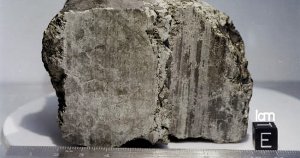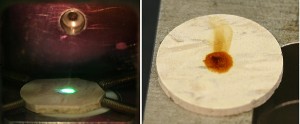The chemical element neodymium is classed as a lanthanide and rare earth metal. It was discovered in 1885 by Carl Auer von Welsbach.

Data Zone
| Classification: | Neodymium is a lanthanide and rare earth metal |
| Color: | silvery-white |
| Atomic weight: | 144.24 |
| State: | solid |
| Melting point: | 1016 oC, 1289 K |
| Boiling point: | 3070 oC, 3343 K |
| Electrons: | 60 |
| Protons: | 60 |
| Neutrons in most abundant isotope: | 82 |
| Electron shells: | 2,8,18,22,8,2 |
| Electron configuration: | [Xe] 4f4 6s2 |
| Density @ 20oC: | 7.0 g/cm3 |
Reactions, Compounds, Radii, Conductivities
| Atomic volume: | 20.6 cm3/mol |
| Structure: | close packed (ABCB) |
| Hardness: | – |
| Specific heat capacity | 0.19 J g-1 K-1 |
| Heat of fusion | 7.140 kJ mol-1 |
| Heat of atomization | 328 kJ mol-1 |
| Heat of vaporization | 283.68 kJ mol-1 |
| 1st ionization energy | 529.6 kJ mol-1 |
| 2nd ionization energy | 1035 kJ mol-1 |
| 3rd ionization energy | 2130 kJ mol-1 |
| Electron affinity | 50 kJ mol-1 |
| Minimum oxidation number | 0 |
| Min. common oxidation no. | 0 |
| Maximum oxidation number | 3 |
| Max. common oxidation no. | 3 |
| Electronegativity (Pauling Scale) | 1.14 |
| Polarizability volume | 31.4 Å3 |
| Reaction with air | mild, ⇒ Nd2O3 |
| Reaction with 15 M HNO3 | mild, ⇒ Nd(NO3)3 |
| Reaction with 6 M HCl | mild, ⇒ H2, NdCl3 |
| Reaction with 6 M NaOH | – |
| Oxide(s) | Nd2O3 |
| Hydride(s) | NdH2, NdH3 |
| Chloride(s) | NdCl2, NdCl3 |
| Atomic radius | 185 pm |
| Ionic radius (1+ ion) | – |
| Ionic radius (2+ ion) | 143 pm |
| Ionic radius (3+ ion) | 112.3 pm |
| Ionic radius (1- ion) | – |
| Ionic radius (2- ion) | – |
| Ionic radius (3- ion) | – |
| Thermal conductivity | 16.5 W m-1 K-1 |
| Electrical conductivity | 1.6 x 106 S m-1 |
| Freezing/Melting point: | 1016 oC, 1289 K |

Meteorite ALH84001. This meteorite, found in Antarctica, may contain fossils of primitive Martian life from over 3.6 billion years ago. The ages and timelines of Martian rock formation can be calculated from the amount of neodymium and tungsten isotopes present. Photo: Nasa
Discovery of Neodymium
Neodymium was first identified in 1885, in Vienna, by Austrian scientist Carl Auer von Welsbach. It was discovered in ‘didymium,’ a substance incorrectly identified by Swedish chemist Carl Mosander as a new element in 1841. (1)
The nonexistent ‘didymium’ was even given the symbol Di in Mendeleev’s first edition of the periodic table in 1869.
In 1879 French chemist Lecoq de Boisbaudran detected and separated samarium from ‘didymium’ in Paris. (1)
After samarium had been discovered, it was noted that ‘didymium’s’ absorption spectrum gave different results depending on which mineral it had been sourced from. (2)
Bohuslav Brauner working in Prague, published a paper on atomic weight determinations in 1882 for rare earth elements and his data for ‘didymium’ were variable.
Brauner became convinced that ‘didymium’ was a mixture of elements; he attempted to separate them, but he was not successful. (2)
In 1885 Carl Welsbach, who had discovered ‘didymium’ 14 years earlier, realized it was actually a mixture of two entirely new elements.
He named these neodymium and praseodymium. Welsbach reacted ‘didymium’ to form nitrate salts, which he then fractionally crystallized from nitric acid to yield pink neodymium and greenish-brown praseodymium salts.
The fractional crystallization experiments were very time consuming, involving more than one hundred crystallization operations, each lasting up to 48 hours.
Neodymium was named with ‘neos didymos’ – Greek for ‘new twin,’ reflecting neodymium’s close association with praseodymium.
Pure neodymium metal was isolated in 1925 by H. Kremers.


Neodymium is used in hybrid car electric motors and generators, cell phones, iPods and wind turbines.

A “neodymium-YAG” (Nd:YAG) laser can be used for decontamination after detonation of a chemical weapon. For example, it can decompose a nerve agent, shown on tile on the right. The laser emits UV light which breaks the molecular bonds, decomposing the nerve agent until it is a harmless brown stain. Photo: Homeland Security.
Appearance and Characteristics
Harmful effects:
Neodymium is considered to be moderately toxic.
Characteristics:
Neodymium is a soft, bright, silvery white metal. It is one of the lanthanide rare earth metals. It forms a flaky oxide coating in air. Unlike many metal oxide layers, this one does not protect the metal from further oxidation.
Neodymium has two allotropic forms, transforming from hexagonal to body-centered cubic above 800K (527 oC).
Neodymium usually exists as a trivalent ion, Nd3+, in its compounds. Most of its salts are pale purple in color.
Uses of Neodymium
Neodymium is used with iron and boron to create powerful permanent magnets, also called NIB magnets. NIB magnets are used in computers, cell phones, medical equipment, toys, motors, wind turbines and audio systems. (3)
Neodymium is used as a crystal (neodymium-doped yttrium aluminum garnet) in lasers. These ND:YAG lasers have numerous applications. For example, they are used in medicine to treat skin cancers and for laser hair removal; and in industry they are used to cut and weld steel.
Neodymium is used to make specialized goggles for glass blowers.
The metal is also used in a spark producing alloy (misch metal) for cigarette lighter flints.
Neodymium salts are used to color glasses and enamels.
Abundance and Isotopes
Abundance earth’s crust: 33 parts per million by weight, 4.8 parts per million by moles
Abundance solar system: 3 parts per billion by weight, 20 parts per trillion by moles
Cost, pure: $420 per 100g
Cost, bulk: $ per 100g
Source: Neodymium is not found free in nature but is found in a number of minerals – mainly monazite and bastnaesite. Commercially it is extracted from monazite and bastnaesite by ion exchange and solvent extraction processes. Neodymium metal can be made by the reduction of anhydrous halides with calcium metal.
Isotopes: Neodymium has 30 isotopes whose half-lives are known, with mass numbers 127 to 156. Naturally occurring neodymium is a mixture of seven isotopes and they are found in the percentages shown: 142Nd (27.2%), 143Nd (12.2%), 144Nd (23.8%), 145Nd (8.3%), 146Nd (17.2%), 148Nd (5.7%) and 150Nd (5.6%). The most abundant isotope is 142Nd at 27.2%.

References
- David R. Lide, CRC Handbook of the Chemistry and Physics 86th Edition., Taylor and Francis., 2005, 4-23.
- Ferenc Szabadváry, Handbook of the Chemistry and Physics of the Rare Earths Vol. 11., Elsevier Science Publishers., 1998, p61.
- Ningbo Bei Ke Strong Magnetic Material Co., Ltd., Neo magnets.
Cite this Page
For online linking, please copy and paste one of the following:
<a href="https://www.chemicool.com/elements/neodymium.html">Neodymium</a>
or
<a href="https://www.chemicool.com/elements/neodymium.html">Neodymium Element Facts</a>
To cite this page in an academic document, please use the following MLA compliant citation:
"Neodymium." Chemicool Periodic Table. Chemicool.com. 17 Oct. 2012. Web. <https://www.chemicool.com/elements/neodymium.html>.